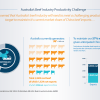The Need For Data Visualisation Skills In Business
A guide to skilling-up your employees
An SAP-sponsored survey recently questioned business leaders about their opinions regarding the uptake and effectiveness of data visualisation tools. A strong majority (86%) felt that their employees would need to become ‘data geeks,’ i.e., they would need to acquire the skills to analyse and interpret data and use that insight to better inform their business decisions.
An understandable sentiment, considering that the first wave of Big Data fever saw enthusiastic investment in generating and collecting information which, in many cases, disappointingly failed to deliver any new insight.
It was because there was over-investment in obtaining the data, but with little mind paid to categorising, analysing and actually understanding what it was saying. Consequently, vast and expensive libraries of information still sit inert and unqueried.
Data Experts could be brought onto the payroll, but there’d remain a disconnect between those with the specialist knowledge and those who could do something decisive with it.
Early in the game, even the tools IT were using to extract and display the relevant information were still too complex and remained practically inaccessible to those who had the ability to put it in a useful context.
In fact, armed with the information but with little understanding of it, not only was it a waste of money, it even had the potential for danger. Over-reliance on poorly-understood data leads inevitably to a false sense of security and bad business decisions.
Amusingly, the shame of it was evident in the survey results – “one in four business leaders gave their company a below average grade on their ability to leverage data for decision making.”
They just weren’t getting the promised ROI, but they still believe in the value of data. The survey suggests these business leaders are throwing up their hands in exasperation and hoping that one day, somehow, their employees will come to magically understand it.
Data visualisation is key
No one actually geeks out over spreadsheets, and even if they did, they just wouldn’t have the speed or the patience to derive anything useful in the time required.
That’s why great data visualisation is the obvious solution, but perhaps comes across as an aspirational but not realisable reality. They see the bold designs and self-animating graphs somehow speaking with the insight of a touch-responsive Minority Report future and, understandably, it seems inaccessible.
Yes, the analytical expertise required to massage meaning from data is a specialised skill, as is the communications design aspect. But, that’s why companies consulting on data analysis and visualisation are exactly who’s bridging the gap between the need for bespoke data solutions and amassing the multidisciplinary teams required to provide it.
As it becomes more widely known that not only do the answers they seek exist somewhere in the data, but that the ability to find and deliver those insights is definitely available, we would expect a reduction in the “31% of business decision makers [who] said they do not currently use or don’t have plans to integrate data visualisation tools.”
It just doesn’t match up with the other stats about business leaders, such as:
· 95% – frequently using company data to back up their decisions and recommendations
· 91% – believing the best data analysis comes from specially-trained data scientists
· 91% – predicting demand for mobile-device visualisation tools will increase
The disconnect is likely a temporal artefact – it will resolve as businesses get used to employing these services, especially in Australia where the pace of paradigm change is somewhat leisurely.
Visualising Insight
The rate at which it’s possible to collect data is increasing exponentially; it’s already surpassed the limit of individual human understanding, which is driving the growing popularity of infographics and business intelligence dashboards, among other visualisation and data analysis tools.
The big innovations we’re aiming at lie in improving the methods of visually presenting those data in interactive visualisations, animated data, and business intelligence dashboards with a goal of promoting near-instantaneous understanding.
Yes, as SAP predicts, we’ll all become ‘data geeks’ as we learn to love the insights data can provide. But the combined skills of data analysis, visual design, and business storytelling are often hard to find in one division, let alone one person. Training analysts to think creatively and visually is hard. But the current deluge of data is asking for tough choices in a resourcing, training, and outsourcing. Some companies get the power of data visualisation; some don’t and will get left behind.
Links
SAP-Sponsored Survey Finds Business Decision Makers Struggle to Unlock the Power of Big Data
Harvard Business Review: Good Data Won’t Guarantee Good Decisions





